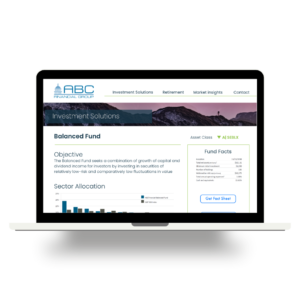Benchmarking and the Tailored Shareholder Report: Staying on the SEC’s Good Side
 Similar to how it handled the Marketing Rule from a few years ago, the SEC is leaving much to the imagination for fund companies when implementing aspects of the Tailored Shareholder Reporting rule.
Similar to how it handled the Marketing Rule from a few years ago, the SEC is leaving much to the imagination for fund companies when implementing aspects of the Tailored Shareholder Reporting rule.
While it is true the agency has provided several required content areas and datasets for inclusion, how exactly those pieces of content and data are to be crafted and presented are somewhat open for interpretation.
From speaking with clients and other fund companies, one of the most discussed and problematic areas for fund teams relates to the SEC’s mandate for the inclusion of an “appropriate broad-based market index” (what we will call BBMI) against which funds can be compared.
What was the SEC’s thinking here?
Why did they decide to change the benchmarking requirements?
What was the logic? And how can fund companies, understanding that logic, approach benchmarking in a way that meets the mandate?
The OIAD Benchmark Study
In April 2022, the SEC’s Office of the Investor Advocate (OIAD) published a report entitled, “How Do Consumers Understand Investment Quality? The Role of Performance Benchmarks.” The report, “examines market data and the results of a large behavioral experiment to understand how fund companies employ benchmarks and how investors respond to the presentation of benchmarks.”
What did the study find? That investors across all levels of sophistication do, in fact, actively use benchmarks to make investment decisions.
The report found that irrespective of the scope of the benchmark (i.e.: narrow vs. broad), fund performance relative to the benchmark in question unequivocally drove investor behavior. As such, the decision to change the regulatory directive to “appropriate broad based market index,” rather than simply an “appropriate index” was an easy one for them to make.
Because the OIAD study found that investors were disinclined to invest in funds with poor performance against their benchmark, to allow funds to find or create narrow benchmarks that could easily show fund “outperformance,” irrespective of market or macroeconomic conditions, clearly works against transparency and a true sense of a fund’s value within a portfolio.
Based on the OIAD study findings, the SEC decided that even in cases where a fund’s strategy does not correlate or is incongruent with broad market fundamentals, enforcing comparison is valuable as it allows investors to understand the alternatives.
In our view, most investors (aside from those demanding ESG or a similar morals-based strategy, or are worried about asset correlation), are agnostic about how their funds are invested, so long as returns potential are maximized (given a specific level of risk, of course).
Investing in a multi-asset or alternative strategy in and of itself must be a means to the end of higher returns.
That’s where the BBMI is such an important requirement, according to the SEC’s way of thinking: it is the more valuable starting reference point.
Benchmarks in the TSR
With the OIAD study in mind, the SEC is mandating a broad-based market index for the Tailored Shareholder Reports.
But what does that mean exactly?
Again, the SEC is being highly non-specific about what constitutes an “appropriate” index.
Broadly, the SEC says that a BBMI is “an index that represents the overall applicable domestic or international equity or debt markets, as appropriate.” So a fund investing in French equities can be compared against an index of the broad French market. However, a fund investing in US-based healthcare companies must use a BBMI of the US equities market.
One would think something like the S&P 500 or Wilshire 5000 would suffice (and we suspect that the SEC would wholeheartedly agree… off the record), but the agency is refusing to publish a list of “approved” indices because (to paraphrase their argument) things change, so it’s better to stay as evergreen as possible with regard to index criteria.
They also don’t want to prejudice fund teams in favor of one benchmark over another.
That said, if we read between the lines, it is tough to imagine a scenario where the SEC punishes a fund company for using one of the major household names in the benchmarking/indexing business.
Narrower Benchmarks are Permissible
Because most investors are primarily concerned with absolute returns, the SEC feels that the BBMI is the most informative way to assess performance (“readily-accessible contextual information about market performance” is their artful description).
Still, the agency recognizes that narrower indices can be highly informative in their own right. Consequently, they are allowing funds to include a narrower, more tailored index that enables peer group comparisons (be it market cap, sector, industry, or asset class, to name but a few possible options).
But these must be in addition to the BBMI, not as a replacement of it.
This concession suggests the SEC understands that narrower benchmarks can often provide more useful information for investors seeking to compare individual funds that follow the same investment style or live in the same investible universe.
In our above example, most investors in a domestic healthcare fund would be interested to see how the fund stacks up against an index of healthcare companies. It speaks to the quality of the investment philosophy, portfolio management, strategy execution, and general skill of the fund’s management team.
If the healthcare sector is up 10% over a 5-year period, but the fund is up only 3% over that timeframe, that’s important information to know, even if the fund itself is up 500 basis points versus the S&P 500.
What the SEC Wants You to Consider
As mentioned above, there is no mandate to use existing benchmarks created by third parties such as Russell or Wilshire, as the SEC doesn’t want to favor one index over another (nor force fund companies to pay licensing fees to specific companies to use their index).
So know that individual fund companies truly have discretion over their benchmarking approach.
Additionally, if firms choose to develop their own benchmark that’s narrower and more customized than something like a total stock market index, the SEC does offer some guidance here.
For example, a multi-asset fund could develop a benchmark that blends one BBMI for the equities market with a BBMI for the fixed income market, or they may simply use two separate BBMIs: one for the equities, one for the fixed income.
Alternately, and this is maybe the most loosey-goosey the SEC gets here, a firm might select an index that shares “economic characteristics with the fund, such as an index that has similar volatility to the fund.”
What that might mean in practice, and how the SEC might evaluate such an index if a compliance investigation is initiated is anybody’s guess.
Fund companies should seek a fair benchmark but be sure that the approach taken is utterly defensible.
In the End, What Point is the SEC Trying to Make?
When the agency enters a period of aggressive changes to its regulatory oversight, it can be instructive to look at it thematically.
There’s new short selling disclosure requirements for hedge funds. The dust is still settling from the new Marketing Rule and all its restrictions on performance-based marketing. There are newly proposed rules governing the use of AI and other predictive modeling, as well as new rules enhancing private fund regulations, but to name a few.
What can we infer about these actions?
To us, there does seem to be a determined effort to place greater burden of proof on actively managed investment strategies to justify the higher fees they charge by requiring them to very clearly, honestly, and overtly demonstrate their efficacy over much cheaper (and often better-performing) index/passive strategies.
Note that boring old index funds aren’t likely to have much of an issue with any of the regulatory changes we noted above.
In order to maintain maximum enforcement leverage (and mask its intentions?), the agency is being as non-specific as possible, just like with many parts of the Marketing Rule. And with the latitude provided, the SEC does seem content with giving fund companies enough rope to hang themselves if their Tailored Shareholder Report benchmarking strategy is too aggressive.
We advise to avoid the appearance of impropriety across the entire spectrum of the TSR rule, but especially as it relates to benchmarking. Keep records and a detailed accounting of how the index was created (or chosen) and why it meets the “appropriate broad based market index” mandate.
Don’t give the SEC the chance to be the SEC. Be forthright and approach the task with appropriate conservatism.
Here are some related resources that might interest you:







 Compare the Top 3 Finserv Content Automation Vendors [White paper]
Compare the Top 3 Finserv Content Automation Vendors [White paper] Create Pitchbooks the Drive Sales [White paper]
Create Pitchbooks the Drive Sales [White paper] Build vs. Buy: Should Your Financial Services Firm Outsource or Insource Marketing Technology? [White paper]
Build vs. Buy: Should Your Financial Services Firm Outsource or Insource Marketing Technology? [White paper]  10 Tips for Rebranding your Fund Marketing Documents [White paper]
10 Tips for Rebranding your Fund Marketing Documents [White paper]


